From the January, 2012 Issue of Cabling Installation & Maintenance Magazine
Expanded sections of the National Electrical Code provide greater clarity on the installation of certain cable types.
By Stanley Kaufman, CableSafe Inc.
The National Electrical Code is published by the National Fire Protection Association with revisions on a three-year schedule. The 2011 NEC, which replaces the 2008 NEC, was released by NFPA in August 2010. There were many changes of interest to manufacturers, installers and users of communications cable and connectivity products. (NFPA 70, NFPA, National Fire Protection Association, National Electrical Code and NEC are registered trademarks of the National Fire Protection Association.)
This is the seventh article in a series of nine articles, contributed on behalf of the Communications Cable and Connectivity Association (CCCA; www.cccassoc.org), concerning those relevant changes in the NEC.
The six preceding articles covered:
- Introduction to the NEC, its scope and organization
- Changes in types and installation rules for data/comm raceways
- Changes in the permitted applications of data/comm cables in air-handling spaces
- Changes in the wiring rules for data/comm cables in riser applications
- Introduction of cable routing assemblies
- Data/comm cable applications
This article discusses the changes in the data/comm cable installation requirements in Articles 770, 800 and 820 of the 2011 NEC. The table within this article lists the affected cables.
Revision of data/comm cable installation requirements
In Articles 770, 800 and 820 of the 2008 NEC, sections 770.113, 800.113 and 820.113 (Installation) only require that listed cables be installed in buildings. Section 770.133, 800.133 and 820.133 only cover the installation of data/comm cables with other cables including electrical cables. It’s the applications sections of these articles, sections 770.154, 800.154 and 820.154, that contain most of the installation requirements for data/comm cables.
In the 2011 NEC, the installation requirements in Articles 770, 800 and 820 have been moved out of the applications sections and into the installation sections (770.113, 800.113 and 820.113). These sections have been greatly expanded to cover the installation of cables, wires, raceways, cable routing assemblies, and also to cover which cables are permitted to be installed in raceways, cable trays and routing assemblies in a variety of environments including air ducts, plenums, risers, general building spaces and in one- and two-family and multifamily dwellings. These sections are quite long and detailed.
Article 770 for example
We will illustrate the increased level of detail with one example, cable trays, from Article 770, Optical Fiber Cables and Raceways.
In the 2008 NEC:
Section 770.154(D) permits any of these types of listed optical fiber cables to be installed in cable trays.
In the 2001 NEC:
Section 770.113(C)(4) permits Types OFNP and OFCP and plenum optical fiber raceways to be supported by open metallic cable tray in other spaces used for environmental air (plenum).
Section 770.113(C)(6) permits any listed optical fiber cable, as well as plenum, riser and general-purpose optical fiber raceways to be supported by solid bottom metallic cable trays with solid metal covers in other spaces used for environmental air (plenums).
Section 770.113(H)(1) permits any listed optical fiber cable to be supported by cable trays.
Section 770.113(H)(2) permits plenum, riser and general-purpose optical fiber raceways to be supported by cable trays.
Section 770.113(H)(3) permits any listed optical fiber cable to be installed in plenum, riser and general-purpose communications and optical fiber raceways that are supported by cable trays.
To see the entire revised installation requirements for data/comm cables please review sections 770.113, 800.113, and 820.113 in the 2011 NEC.
The 2014 NEC
The expansion of sections 770.113, 800.113, and 820.113 to provide detailed installation requirements was done for two reasons. First, the removal of installation requirements from the applications sections required that the installation requirements be moved to the appropriate place. And second, expanding the detail of the installation requirements greatly improved clarity.
If you agree that these changes increase the clarity of the installation requirements for data/comm cables, then introducing similar revisions into Articles 725 and 760 is a logical next step.
November 4, 2011 was the deadline for proposals for the 2014 NEC.
My next article will deal with data/comm cables in computer rooms.
Author’s disclaimer: This paper, provided by the Communications Cable and Connectivity Association (CCCA), is offered for general information and educational purposes. It is not offered, intended, nor should it be relied upon as legal advice. The paper does not set forth the views of any member or any other party, nor may it be taken as such. CCCA makes no warranty regarding the accuracy of the information provided in this paper, and expressly disclaims any implied warranties and any liability for use of the paper or reliance on views expressed in it. CCCA does not endorse, approve or certify any information set forth in this paper, nor does it guarantee the accuracy, completeness, efficacy, timeliness or correct sequencing of such information. Use of the paper and the views expressed in it is voluntary, and reliance on it should only be undertaken after an independent review of its accuracy, completeness, efficacy and timeliness, and based on the individual facts and circumstances of a user.
Stanley Kaufman, Ph.D. is principal of CableSafe Inc. and a consultant to the Communications Cable and Connectivity Association (CCCA; www.cccassoc.org). He is a member of NEC Panel 12 (responsible for Article 645) and Panel 16 (responsible for optical fiber and communications cables).

